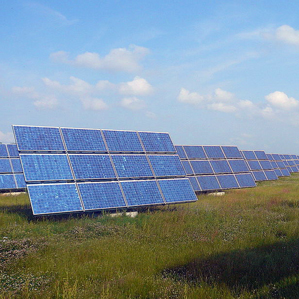How Can Solar Power Better Compete?
As solar power has spread in recent years, its cost has come down significantly, but in most places it remains more expensive than electricity from other sources. For that to change, solar manufacturers will have to lower the cost of the materials used in solar cells and find ways to further increase the cells’ efficiency—the amount of light they convert into electricity. Here are some ways researchers are making progress on these problems.

Boosting Efficiency
Highly efficient solar cells like those on the Mars Rover require a production process that is too costly for most consumer applications. Solar cells like those on the roofs of houses come at a significantly lower price, but their efficiency is theoretically limited to around 34 percent, in part because they can turn only certain wavelengths of light into electricity. However, University of Utah researchers Rajesh Menon and Peng Wang say they have found a way to convert more wavelengths and make the solar cells on roofs up to 50 percent more efficient. They can create a thin layer of glass or plastic called a polychromat that can be placed over a solar cell and direct different types of light to separate cell layers that absorb each kind. Menon and Wang hope that manufacturers could implement the technology within the next five to 10 years. The finding was unveiled in June in the journal Progress in Photovoltaics: Research and Applications.
Bathed in Light
A chemical found in ocean water, already used to make tofu and bath salts, could replace a toxic ingredient in solar panel production at a third of the cost, says University of Liverpool physicist Jon Major. This compound, magnesium chloride, would take the place of cadmium chloride, which has been widely applied to solar cell films for the past 25 years to boost their efficiency. A huge drawback of cadmium chloride is that it requires extensive safety protocols for workers and special handling when it is thrown away. Magnesium chloride is much safer and can be applied to the solar cells with a simple spray gun, notes Major, who explains more about the manufacturing process in this video. The research was first published online in the journal Nature in June.
Spiking Silicon
In even the most efficient solar panels, some light will be reflected instead of being absorbed to produce energy. But a manufacturing process developed by Rice University researchers Andrew Barron and Yen-Tien Lu could offer a way to capture more than 99 percent of the sunlight hitting a solar cell. This new process involves etching silicon to create nanoscale “spikes” that are smaller than wavelengths of light. The resulting material, known as black silicon, can capture light from any angle and reflects barely any of it. Making black silicon previously required a two-step process, but the Rice researchers have demonstrated that they can create the material in one step at room temperature. The research was first published online in the Royal Society of Chemistry’s Journal of Materials Chemistry A in June.
Sustainable Solar
Solar cells made from a compound called perovskite seem to hold great promise for their high efficiency and affordable cost. However, the use of lead ore in the manufacturing process has negative health and environmental consequences. Hoping to avoid this, MIT researchers have demonstrated a way to make these types of cells from old car batteries. About 30 households could be powered with the lead from just one recycled battery because the perovskite required for these cells is only half a micrometer thick, says the team, led by professors Angela Belcher and Paula Hammond. The research was published online in the journal Energy and Environmental Science on July 23.
The takeaway:
Research efforts to make solar panels more efficient could bring down the costs of solar installations. For example, Glint Photonics says it can cut the cost of solar cells in half with a new material that can change its reflectivity to capture light at different angles, and North Carolina-based Semprius says it can boost cell efficiency to 50 percent through a new method of stacking solar cells on top of each other. But so-called “soft costs” like permit fees continue to make up more than 60 percent of installation costs, a 2013 study from the U.S. Department of Energy’s National Renewable Energy Laboratory shows. Such issues could continue to make solar installations less than affordable in many places.
Do you have a big question? Send suggestions to questionoftheweek@technologyreview.com.
Keep Reading
Most Popular
Large language models can do jaw-dropping things. But nobody knows exactly why.
And that's a problem. Figuring it out is one of the biggest scientific puzzles of our time and a crucial step towards controlling more powerful future models.
The problem with plug-in hybrids? Their drivers.
Plug-in hybrids are often sold as a transition to EVs, but new data from Europe shows we’re still underestimating the emissions they produce.
Google DeepMind’s new generative model makes Super Mario–like games from scratch
Genie learns how to control games by watching hours and hours of video. It could help train next-gen robots too.
How scientists traced a mysterious covid case back to six toilets
When wastewater surveillance turns into a hunt for a single infected individual, the ethics get tricky.
Stay connected
Get the latest updates from
MIT Technology Review
Discover special offers, top stories, upcoming events, and more.